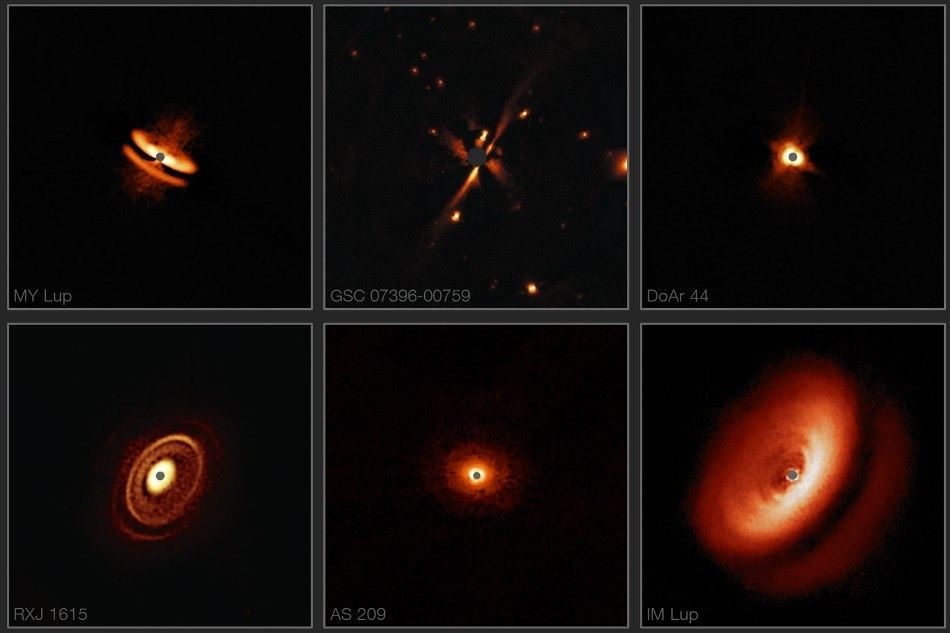Apr 16 2018
Researchers at ETH Zurich have partially developed and assembled an instrument, which has now been specifically successful in analyzing newborn stars that are still surrounded by dust and gas.
 New images from the SPHERE instrument on ESO’s Very Large Telescope are revealing the dusty discs surrounding nearby young stars in greater detail than previously achieved. They show a bizarre variety of shapes, sizes, and structures, including the likely effects of planets still in the process of forming. (Image credit: ESO/H. Avenhaus et al./DARTT-S collaboration)
New images from the SPHERE instrument on ESO’s Very Large Telescope are revealing the dusty discs surrounding nearby young stars in greater detail than previously achieved. They show a bizarre variety of shapes, sizes, and structures, including the likely effects of planets still in the process of forming. (Image credit: ESO/H. Avenhaus et al./DARTT-S collaboration)
Using Spectro-Polarimetric High-contrast Exoplanet REsearch (SPHERE) at the European Southern Observatory (ESO), astronomers from ETH Zurich and Max Planck Institute for Astronomy in Heidelberg could capture images of planet-forming disks surrounding the young stars: the disks, known as protoplanetary disks, occur around so-called TTauri stars - the progenitors to our Sun - and also surrounding the more massive siblings known as Herbig Ae/Be stars.
Thus far, the focus of the astronomers was primarily on Herbig Ae/Be stars; however, with the help of a new, ambitious program known as Disks Around TTauri Stars with SPHERE (DARTTS-S), Henning Avenhaus and Sascha Quanz, former and current members of the NCCR PlanetS at ETH Zurich, have now been able to exploit the capabilities of SPHERE to carry out a survey of TTauri disks.
The outcomes for the first eight stars have been reported in a paper published in the Astronomical Journal. “Not only were we able to clearly detect all eight disks,” summarized Henning Avenhaus, “but, surprisingly, they looked all very different in particular with respect to their size.” Although some of the stars could be detected with only a radius of 80 au (80 times the distance from Sun to Earth and around twice the average distance between Sun and Pluto), others were detected to have an astonishing radius of 700 au.
“Most of the disks were found to display rings, a phenomenon known from previous observations of more massive stars,” explained Sascha Quanz: “However, none of them displayed spiral structures, which is a phenomenon seen regularly in Herbig disks.” Of importance now is to know from where this difference arises and its inference for planet formation around distinctive types of stars.
Start on a Bad Footing
As Henning Avenhaus remembered, although the project was very successful, it started on a bad note: “While the first proposal to undertake such observations was already written in March 2013 and highly rated (back then using the older NACO instrument), unexpected works that had to be performed on the instrument made it impossible to take data.”
A similar thing happened again in September 2013—the instrument was not available again. The requested scheduling was achieved by means of a third attempt in March 2014—in March 2015, Henning Avenhaus traveled to see the telescope only to find out that the instrument (still NACO) had a glitch the night before the start of the observations was scheduled. Incidentally, clouds and wind rendered it impossible to observe anyhow.
At that moment, the team considered the new instrument - SPHERE - as an alternative and got their first observations scheduled in March 2016. As Henning Avenhaus remembered, things fell in place this time as the instrument as well as the weather worked out well: “I was present at Cerro Paranal, the location of the Very Large Telescope, working through the nights to perform the observations and occasionally peaking out of the control room to head to the telescope platform and marvel at the impressive display of stars.”
The data collected during the course of several nights in March 2016 and in the next year were of extremely high quality. Over half a decade after the program was conceptualized, the scientists have now been rewarded with results that will help in elucidating the formation processes of planets.
“This high-quality dataset impressively shows the power of SPHERE for these observations and significantly increases the number of planetary nurseries studied at high resolution enabling us to eventually get a statistical grasp on planet formation,” summarized Sascha Quanz. Further results from the DARTTS-S program and analogous observations performed using the ALMA radio telescope in Chile should assist in achieving this.